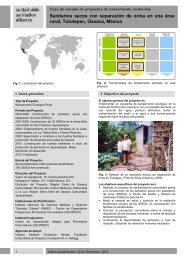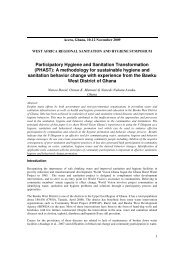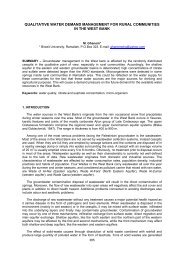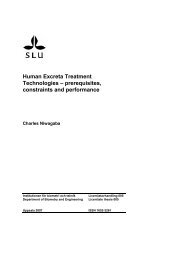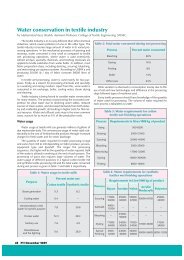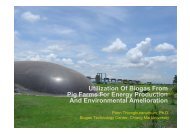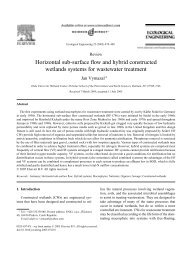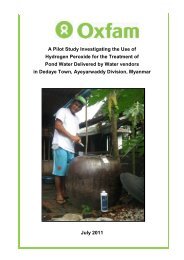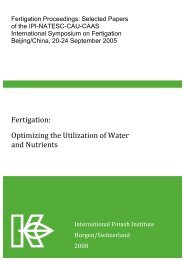Experiences with urine diverting dry toilets - EcoSan Club
Experiences with urine diverting dry toilets - EcoSan Club
Experiences with urine diverting dry toilets - EcoSan Club
Create successful ePaper yourself
Turn your PDF publications into a flip-book with our unique Google optimized e-Paper software.
<strong>Experiences</strong> <strong>with</strong> UDDTs in EECCA countries<br />
workshop where the first<br />
demonstration toilet was built<br />
by WECF trainers. An important<br />
aspect is the adaption of the<br />
UDDT technology to local<br />
conditions (e.g. using locally<br />
available materials) and for<br />
demonstration. All partners<br />
developed criteria for the<br />
selection of beneficiaries,<br />
which differed somewhat<br />
per partner. Common criteria<br />
were the commitment to use<br />
the UDDT as meant, including<br />
proper cleaning and the<br />
sanitation products (<strong>urine</strong> and<br />
sanitized faeces) as fertilizer,<br />
the willingness to demonstrate<br />
their toilet to others and to countries (2003-2010).<br />
lesser extend removal of the<br />
old pit latrine. Some partners included poverty as a<br />
criterion for beneficiary selection, but others choose<br />
to also build <strong>toilets</strong> for (relatively) better off families,<br />
including those of local leaders, to avoid UDDTs being<br />
seen as a solution just for the poor. Several partners<br />
gave preference to larger families, especially <strong>with</strong><br />
several children, women and/or girls. Another common<br />
criterion was the absence of a proper existing toilet or<br />
the intention to build conventional <strong>toilets</strong> (i.e. whether<br />
a central sewage system and/or central water supply<br />
system (for flushing) was absent).<br />
The main drivers for people to become a beneficiary for<br />
a UDDT were the following aspects:<br />
• Dissatisfaction <strong>with</strong> the pit latrine, especially<br />
no comfort (cold, windy, smell and flies) and<br />
difficulties <strong>with</strong> cleaning<br />
• In areas <strong>with</strong> high groundwater level, there is<br />
a lot of smell and the need to move the latrine<br />
frequently<br />
• Interest to obtain cheap fertilizer such as <strong>urine</strong><br />
(mainly among farmer-orientated households)<br />
For the successful introduction of UDD technology and<br />
its sustainability, adequate training and awareness<br />
raising is crucial. That is why the implementation<br />
is always accompanied by hygiene training and<br />
workshops. In Central Asia WECF adopted the WHO tool<br />
“Participatory Hygiene and Sanitation Transformation”<br />
(PHAST) into one that is in line <strong>with</strong> resources-oriented<br />
sanitation: „Participatory Hygiene and Ecological<br />
Sanitation Transformation“ (PHAEST). This tool helps<br />
participants to analyse their hygiene behaviour, discuss<br />
safe and unsafe <strong>toilets</strong> and learn about pathogens in<br />
excreta. The use, cleaning and maintenance of UDDTs<br />
are discussed in a participatory way. This PHAEST tool<br />
was especially adopted in the Central Asian countries,<br />
but the above topics were included also in the training<br />
Sustainable Sanitation Practice<br />
Figure 1: Number of individual <strong>toilets</strong> constructed by the WECF network in EECCA<br />
17<br />
and awareness activities in the other countries. These<br />
training and awareness activities seem to have been<br />
well effective in the sense that they enabled the<br />
construction and (largely) proper use of UDDTs.<br />
Only in Afghanistan the situation on the implementation<br />
of the UDDTs was different from the other countries<br />
and the local partner worked very independently<br />
based on its own experience <strong>with</strong> the local culture<br />
and background. That is why and due to the political<br />
situation this paper is basically about the experiences<br />
in the other countries where a closer monitoring was<br />
feasible.<br />
Location, design and material of the <strong>toilets</strong><br />
Location<br />
People in the rural areas of the EECCA country mostly<br />
have a toilet – commonly a pit latrine in their garden.<br />
Due to often unhygienic situations, smell and problems<br />
<strong>with</strong> flies, the location of the pit latrine is far from<br />
the house, sometimes close to the livestock. When<br />
introducing UDDTs people first are very skeptical about<br />
placing the toilet close to the house or even indoor<br />
because they cannot imagine that the technology is<br />
odor free and hygienic. To raise awareness about the<br />
advantages of the UDD technology, it is helpful to<br />
build first a demonstration toilet or to visit an existing<br />
functioning UDDT.<br />
In general, the people in Eastern Europe and the<br />
Caucasus are more open to construct the <strong>toilets</strong> indoor<br />
while in Central Asia most <strong>toilets</strong> are constructed<br />
outdoor.<br />
As the photos display, the realized toilet design and<br />
location were various. In the trainings, the principles<br />
of ecosan were explained in detail (2) and the partners<br />
were encouraged to make their own designs <strong>with</strong> locally<br />
available material. The local partners were often very<br />
creative.<br />
Issue 6/2011



